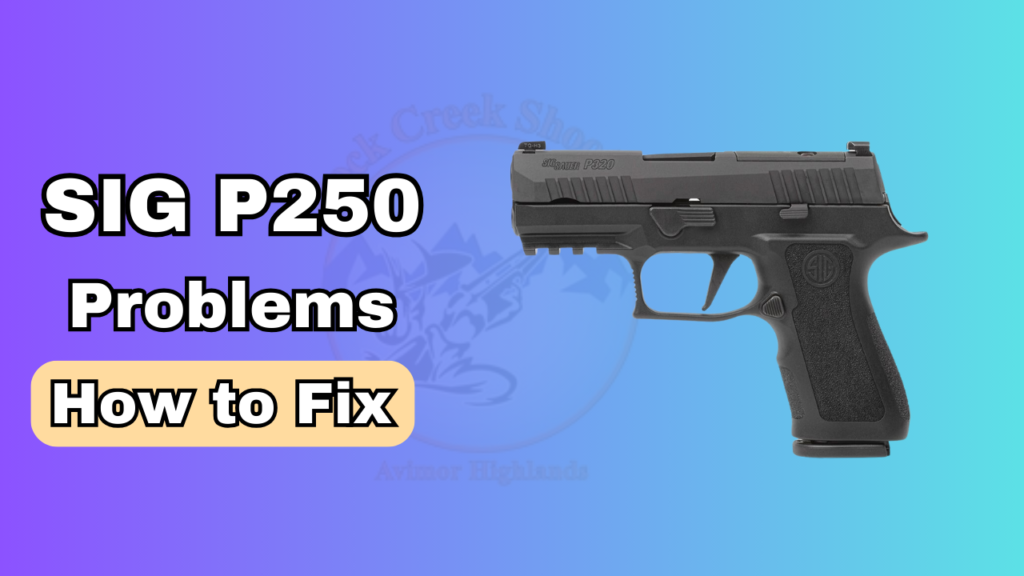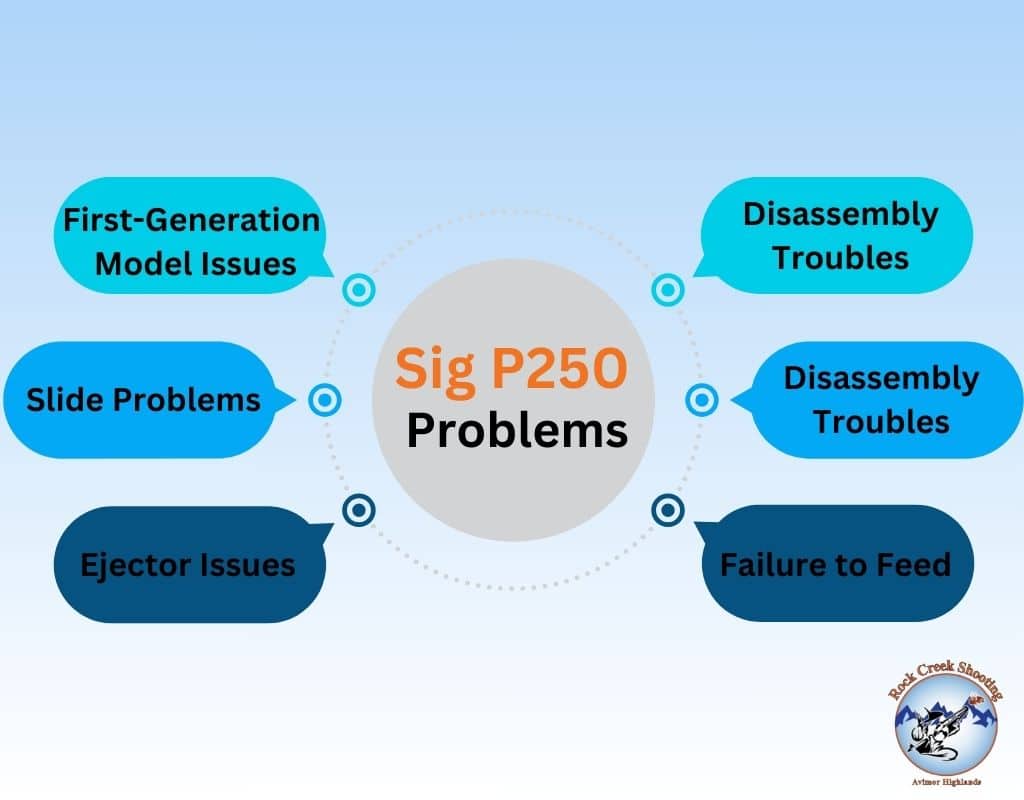
The Sig P250, a trailblazer in the modular firearms universe, has garnered both admiration and scrutiny over its lifecycle. Known for its versatility and reliability, it’s not surprising that it has found a home with various users, from law enforcement to everyday carriers.
Yet, no firearm is free from critique or the occasional hiccup. In the journey of understanding the Sig P250 more intimately, we’ll be unpacking the layers behind the common issues faced by its users.
From the nuanced difficulties of its DAO trigger to its first-generation quirks, let’s navigate through these waters together, shall we? Our aim? To arm you with the knowledge to make the most out of your Sig P250 experience.
Problems and Solutions Overview

| Problem | Short Solution |
| First-Generation Model Issues | Ensure your gun has a true Picatinny rail, not a rounded Sig style rail. |
| Slide Problems | Use a rubber mallet to gently tap the base of the magazine well, or switch to a metal frame. |
| Ejector Issues | Use high-quality ammo such as Speer Lawman 147gr FMJ or 147gr Win Defend (JHP). |
| Failure to Feed | Switch to Winchester ammo and polish the rails. |
| Disassembly Troubles | Rotate the takedown lever 90 degrees and aim the rifle upward during disassembly. |
| Trigger Issue | This comes down to personal preference; some may find aftermarket options to adjust the trigger pull to their liking. |
Overview of the Sig P250
The Sig P250 stands out as a testament to Sig Sauer’s innovative approach to firearm design. It’s the jack-of-all-trades in the truest sense, offering unprecedented modularity that caters to nearly every user’s preference.
Whether you’re in the law enforcement sphere, a competitive shooter, or someone who appreciates the craftsmanship of a reliable daily carry, the P250 has something for you.
But, let’s chat honestly, shall we? No piece of technology, especially firearms, comes without its set of challenges. The Sig P250, with its DAO (Double Action Only) trigger, has sparked debates among users.
Some praise its consistency and safety features, while others find it less appealing compared to the lighter, shorter trigger pulls of its competitors.
Beyond the trigger, early adopters of the P250 faced hurdles with first-generation models that included issues from feeding to slide retention.
However, true to Sig Sauer’s commitment to excellence, advancements and iterations have addressed many of these early concerns, showcasing the company’s responsiveness to user feedback.
In essence, the Sig P250 is more than just a firearm; it’s a versatile platform that has evolved over time.
It caters to a wide audience by offering an array of calibers, sizes, and grip options, making it a noteworthy contender in the crowded field of handguns. So, as you journey with your Sig P250, remember, understanding its intricacies is part of the relationship between a shooter and their trusted tool.
Common Sig P250 Problems, Solution & Reason
First-Generation Model Issues
Have you ever picked up a first-gen Sig P250 and found yourself in a bit of a pickle with it? You’re not alone. Early versions of the P250 had their fair share of drama, from jamming up to having that not-so-smooth operation we all crave in a firearm.
The Solution
The fix for navigating around these first-gen frustrations isn’t as complex as you might think. Ensure that your P250 is updated with a true Picatinny rail, not the rounded Sig style that initially came with it.
This simple swap can make a world of difference in functionality. Plus, giving your firearm a once-over to check that everything’s sitting right, including the guiding rod, can prevent those unnecessary headaches.
The Reason
The crux of the issue often lies in the design nuances of the first-generation models, particularly with the rail and guide rod setup. By addressing these, you align your P250 closer to its newer, more refined siblings.
Slide Problems
Ever loaded your magazine into your Sig P250, only to have the slide decide it’s time to jump forward uninvited? It’s like the slide has a mind of its own, right? Quite the odd behavior that can throw you off your game.

The Solution
This quirky behavior can often be traced back to the slide-lock mechanism getting a bit too jostled when the mag is inserted. A surprisingly simple workaround? If you’re up for a minor DIY project, a gentle tap on the base of the magazine well with a rubber mallet might just do the trick.
Alternatively, considering a switch to a metal frame can offer a more permanent fix by adding that extra bit of weight and stability.
The Reason
The unexpected slide advancement usually stems from the interplay between the magazine’s insertion force and the slide lock’s sensitivity. Balancing this relationship is key to keeping your slide in check.
Ejector Issues
Nothing quite ruins a day at the range like having spent casings bounce off your forehead, thanks to an overly enthusiastic ejector. It’s like the firearm is playing a practical joke on you, but you’re not laughing.

The Solution
Before you start questioning your Sig P250’s manners, take a closer look at the ammo you’re feeding it. High-quality ammunition can make all the difference. Opt for reputable brands like Speer Lawman 147gr FMJ or 147gr Win Defend (JHP) to keep your shooting experience bump-free.
It’s amazing how the right ammo can turn things around, keeping those casings in line and away from you.
The Reason
More often than not, ejector woes are a tale of questionable ammunition quality. Investing in better rounds can save you from the unpredictability of wayward casings.
Failure to Feed
Encountering a “Failure to Feed” (FTF) scenario can be a real dampener, especially when you’re all set for some quality time with your P250. It’s like the firearm is on a hunger strike, refusing to chamber rounds properly.

The Solution
The path to resolving FTF dilemmas might require a bit of trial and error with your ammo selection. Surprisingly, switching to Winchester ammunition has proven to be a game-changer for many.
Additionally, giving those rails a good polish not only keeps your Sig P250 looking sharp but also smoothens the feeding process, ensuring every round finds its home.
The Reason
FTF issues often boil down to the compatibility between your firearm and the ammunition. Finding the right match is crucial for a seamless shooting experience.
Read More: 4 Common SIG SP2022 Problems + How To Fix Them
Disassembly Troubles
Disassembling your Sig P250 shouldn’t feel like you’re wrestling with an obstinate puzzle. If you find the slide playing hard to get, know that you’re not the only one facing this challenge.

The Solution
Sometimes, it’s all about approaching the problem from a different angle—literally. By rotating the takedown lever 90 degrees and aiming the firearm upward, you introduce a slight shift in the internal components, making the slide more cooperative.
It’s a little trick that can save you a lot of frustration, making maintenance that much easier.
The Reason
The difficulty with disassembly typically stems from alignment issues within the firearm’s internal mechanism. A slight adjustment in how you handle the process can make all the difference.
Trigger Issue
Ah, the trigger. It’s where your relationship with your Sig P250 truly becomes personal. If you find the trigger pull a tad too long for comfort, rest assured, you’re not treading this path alone.

The Solution
When it comes to the trigger, there’s no one-size-fits-all fix. It really boils down to personal preference. Some shooters find solace in aftermarket options that allow for a customized trigger feel. Whether you’re looking for a shorter pull or a lighter touch, there’s likely a modification out there for you.
The Reason
Trigger dissatisfaction usually centers around personal preference and shooting style. Finding the right trigger setup is key to harmonizing with your firearm.
Closing Thoughts
As we wrap up our journey through the ins and outs of the Sig P250, it’s clear that this firearm, like any other, comes with its unique set of challenges and quirks.
From the peculiarities of the first-generation models to the nuances of the trigger pull, the P250 is a testament to the idea that no tool is without its need for understanding and adaptation.
Remember, encountering issues with your Sig P250 isn’t a sign of defeat. Instead, it’s an opportunity for troubleshooting, learning, and ultimately, mastering your firearm.
The solutions we’ve discussed aren’t just fixes; they’re part of a larger conversation between you and your P250, one that evolves as you spend more time together.
So, keep your head up and your tool kit ready. The road to a seamless Sig P250 experience might have a few bumps, but with the right approach, it’s undoubtedly a rewarding journey.
After all, mastering the challenges only makes the shooting experience that much sweeter.
Sig P250 Problems FAQ
Why did SIG Sauer discontinue the P250?
The shift towards models like the P320, which offers a striker-fired alternative with similar modularity, reflected market demand and advancements in firearm technology, leading to the phase-out of the P250.
Is the Sig P250 a good gun?
Absolutely. The P250 is renowned for its accuracy, reliability, and unparalleled modularity. Its unique DAO trigger system and interchangeable components make it a versatile choice for many shooters.
What is the difference between the P250 and P320?
While both pistols offer SIG Sauer’s pioneering modular design, the main difference lies in the firing system. The P250 uses a DAO (Double Action Only) system, while the P320 is a striker-fired platform, resulting in different trigger feels and operation mechanics.
Can I fix the trigger pull on my Sig P250?
Yes, you can. While the factory trigger is designed to suit a wide range of shooters, aftermarket options and adjustments are available for those seeking a customized trigger pull experience.
Are there any known recalls for the Sig P250?
No widespread recalls specifically targeting the Sig P250 have been announced. However, like any responsible firearm owner, it’s good practice to keep an eye on manufacturer notices and updates regarding your model.
How can I prevent failure to feed issues with my P250?
Using high-quality ammunition and ensuring your firearm’s rails and magazine are clean and properly maintained can significantly reduce failure to feed issues. Sometimes, switching ammo brands can also provide a straightforward solution.
The SIG P250 Community
On the hunt for unfiltered opinions and deep dives on the SIG P250? Reddit and other community forums are your goldmine. knowledge is the key, remember?

